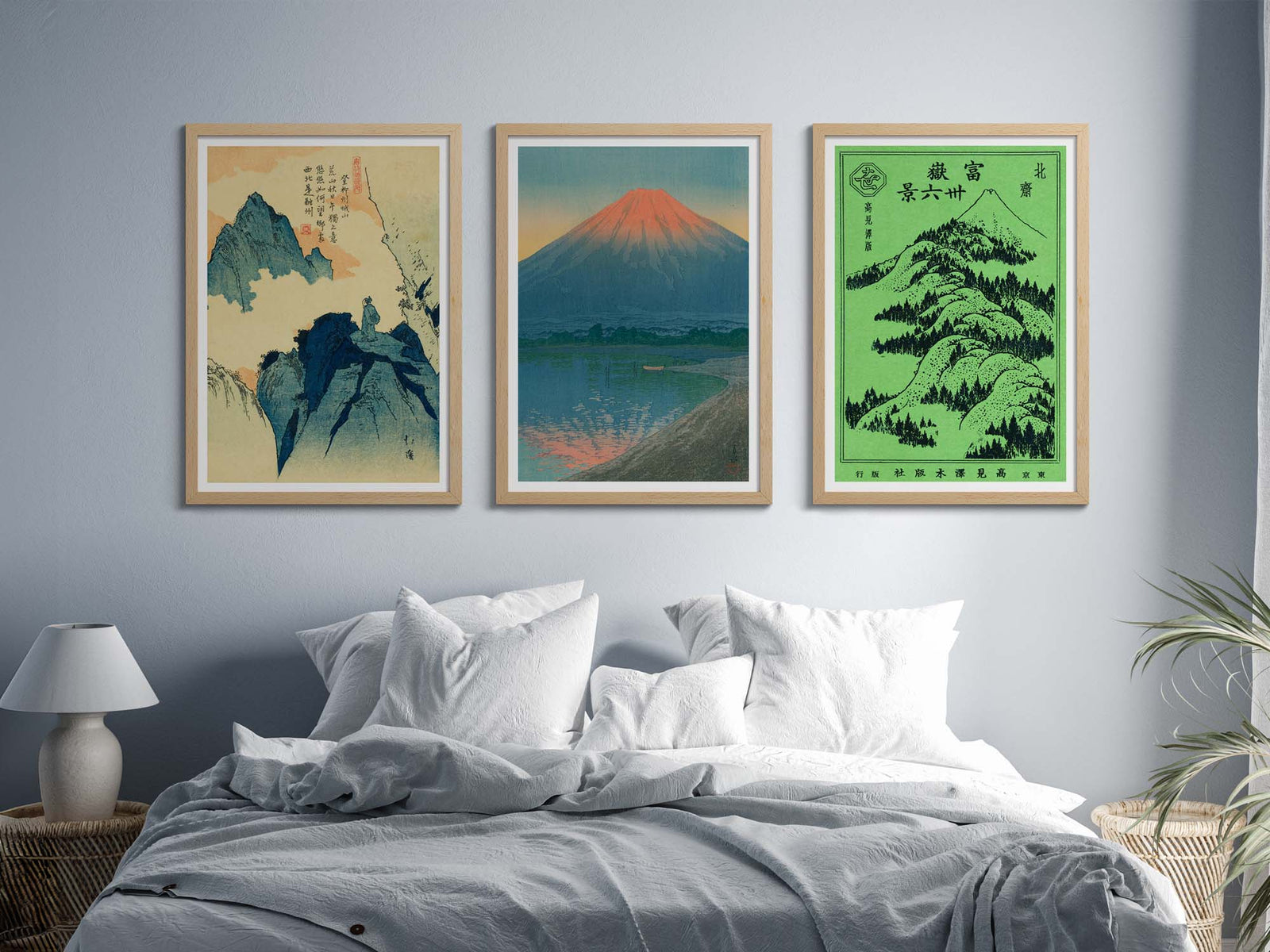Where Earth Touches Sky: Japanese Mountains in Print
Sophie Langford
·
6 June 2025
·
4 min read

There’s something uniquely spellbinding about the way Japanese artists depict mountains. They’re never just landforms or distant backdrops — they’re thresholds, metaphors, weather-bearers. Across centuries of brushwork, woodblock, and ink, these peaks become more than geology; they become emotional architecture.
In curating this collection, I found myself drawn to the way these works hold tension between stillness and motion. You’ll find ink-stained outlines dissolving into mist, hikers climbing zig-zag trails carved into narrative scrolls, and moonlit lakes that cradle Mount Fuji like a sleeping deity. From Edo-period woodblock artists like Hokusai and Hokkei to painters like Bairei and Hasui, this is a journey into how landscape becomes memory — and how mountains, especially in Japanese art, are often less about ascent and more about perspective.
...
Silhouettes and Skylines
Mountains are, at heart, a matter of shape. They rise and fall like punctuation on the horizon — sometimes gentle, sometimes abrupt, always suggestive. In Japanese art, especially ink and woodblock works, these silhouettes often act less as topographical fact and more as a kind of visual poetry. Think ink trails that vanish into mist, or the graphic repeat of overlapping ridges that look like thoughts drifting into the distance.
A whisper of a landscape — this soft ink wash painting is all about restraint. Kiitsu, a painter of the Rinpa school, was known for his compositional balance and tonal sensitivity. Here, peaks emerge from grey washes like half-formed memories. It’s a piece that invites stillness, ideal for a calming corner or minimalist gallery wall.
Mountains Upon Mountains, by Katsushika Hokusai
Hokusai’s mountainous forms here take on a rhythmic quality, layered like waves in slow motion. Known for his bold linework and balance of dynamism and control, Hokusai often turned the landscape into architecture — and here, it’s sculptural. There’s something deeply meditative about this repetition, as though the mountains themselves are breathing.
Mountain Landscape with a Stream, by Totoya Hokkei
A more lyrical take, Hokkei’s composition winds mist and water through multiple ridgelines, with gentle foliage softening the ascent. Hokkei, a student of Hokusai, brings a more romantic flair to the scene. The sense of flow — water, mist, mountain — gives the print a lovely seasonal ambiguity. Perfect for a restful reading nook or hallway.
Pathways and Perspectives
Mountains can be monumental, yes — but in Japanese art, they’re also intimately walkable. A zig-zag trail here, a meandering path there. Sometimes it’s the road that tells the story more than the peak itself. These prints explore the mountain not as backdrop but as something lived — climbed, travelled, or simply passed beneath. It’s a gentle reminder that perspective is shaped by how we move through the world, not just what we stand and look at.
Climbing a Mountain in Liuzhou, by Totoya Hokkei
A winding staircase slices up the terrain, its bends echoing the folds of the surrounding cliffs. Hokkei’s figures appear small, nearly lost in the scale of the ascent — but that’s part of the point. The mountain isn’t a goal, but a presence. There’s something almost cinematic about the layering of foreground and backdrop here, suggesting journey and transformation.
1930's Kirishima, Kagoshima Prefecture, Japan
This vintage Japanese travel poster captures the volcanic slopes of Kirishima with stylised confidence — ochre ridges, bold contour lines, and that crisp Art Deco typographic treatment. It’s mountain-as-destination, framed for adventure. There’s an optimism to this piece, the kind of energy that belongs in a hallway, studio, or anywhere you want a little motion in the air.
Chinese Poem, by Totoya Hokkei
Here, the mountain plays quiet accompaniment to a solitary figure and a column of brush-calligraphed text. Hokkei often wove poetry into his prints, and this one is as much about thought as it is about place. The traveller, the terrain, and the written word form a kind of triangle — suggesting that the climb isn’t just physical, but reflective too.
Mountains in Bloom and Haze
Sometimes a mountain doesn’t announce itself — it reveals itself. In blossom season or high summer, the peaks of Japan become veiled, not in snow, but in mist, pollen, and heat shimmer. Artists have long captured this transience: the way a single tree or wild breeze can transform an entire mountain-scape into something dreamlike. These are prints you feel more than you see — textured with softness, haze, and half-remembered scent.
Bairei, known for his bird-and-flower paintings, brings a similar delicacy to this mountain view. A flowering tree arcs into the foreground, its blooms suspended like paper lanterns. The mountain itself is light, almost abstract — background becoming atmosphere.
Summer Landscape, by Soga Shohaku
A burst of expressive energy, Shohaku’s summer vision borders on the fantastical. His mountains twist and rise with an almost animal motion, clouds curling like smoke. A true original of the Edo period, Shohaku’s brush seems to race the weather. It’s a work that feels alive — ideal for a space that embraces the unusual, the spirited, and the bold.
The Fuji Finale
There’s Mount Fuji, and then there’s the idea of Mount Fuji — the symbol, the muse, the myth. It has been drawn, carved, photographed, and printed more than any other mountain in Japan, yet never loses its pull. In Japanese art, Fuji is rarely just a mountain. It’s a mirror. A constant. A centre of gravity, rendered again and again not to show what it looks like, but what it feels like.
Lake Yamanaka and Mount Fuji, by Kawase Hasui
A cool, glassy lake reflects Fuji’s elegant symmetry, softened by pine and mist. Hasui’s Shin-Hanga style blends tradition with a modern sensibility — and this print is a perfect example. Quietly composed but rich in tone, it brings together water, architecture, and that iconic volcanic cone into something almost meditative.
Fine Wind, Clear Morning, by Katsushika Hokusai
Also known as Red Fuji, this is perhaps the most famous image of the mountain ever made. Hokusai captures the mountain glowing in early sunlight — the red, the stillness, the quiet grandeur. Part of his Thirty-Six Views of Mount Fuji series, it’s a piece that needs little introduction but always deserves another look. Perfect in almost any interior, from minimalist to maximalist.
...
Whether cloaked in ink or awash with blossom, the mountains of Japan have long offered artists more than a subject — they offer a sense of scale, of stillness, of story. In these ten prints, we’ve travelled across Meiji-era paths, stepped into tea houses tucked beneath the clouds, and glimpsed Fuji at her most iconic.
What’s remarkable is not just the variety of styles — from Shin-Hanga to surreal reinterpretation — but the emotional range they hold. Some are meditative. Others, bold. All of them, though, invite pause. And perhaps that’s the true gift of mountain prints: they don’t just decorate a space, they expand it.
Whether you’re curating a calming gallery wall or looking to bring a little breath into your interiors, these peaks are more than decorative. They’re perspective.


















Sophie Langford
Sophie Langford is an art enthusiast and long-time blogger with a passion for the spaces where design and creativity meet. With years of experience writing for leading art and design blogs, Sophie now focuses on curating content that helps readers draw inspiration from the art world to elevate their own living spaces. From emerging design trends to timeless classics, she brings a keen eye for style and a love of storytelling to every post.
Comments (0)
No comments